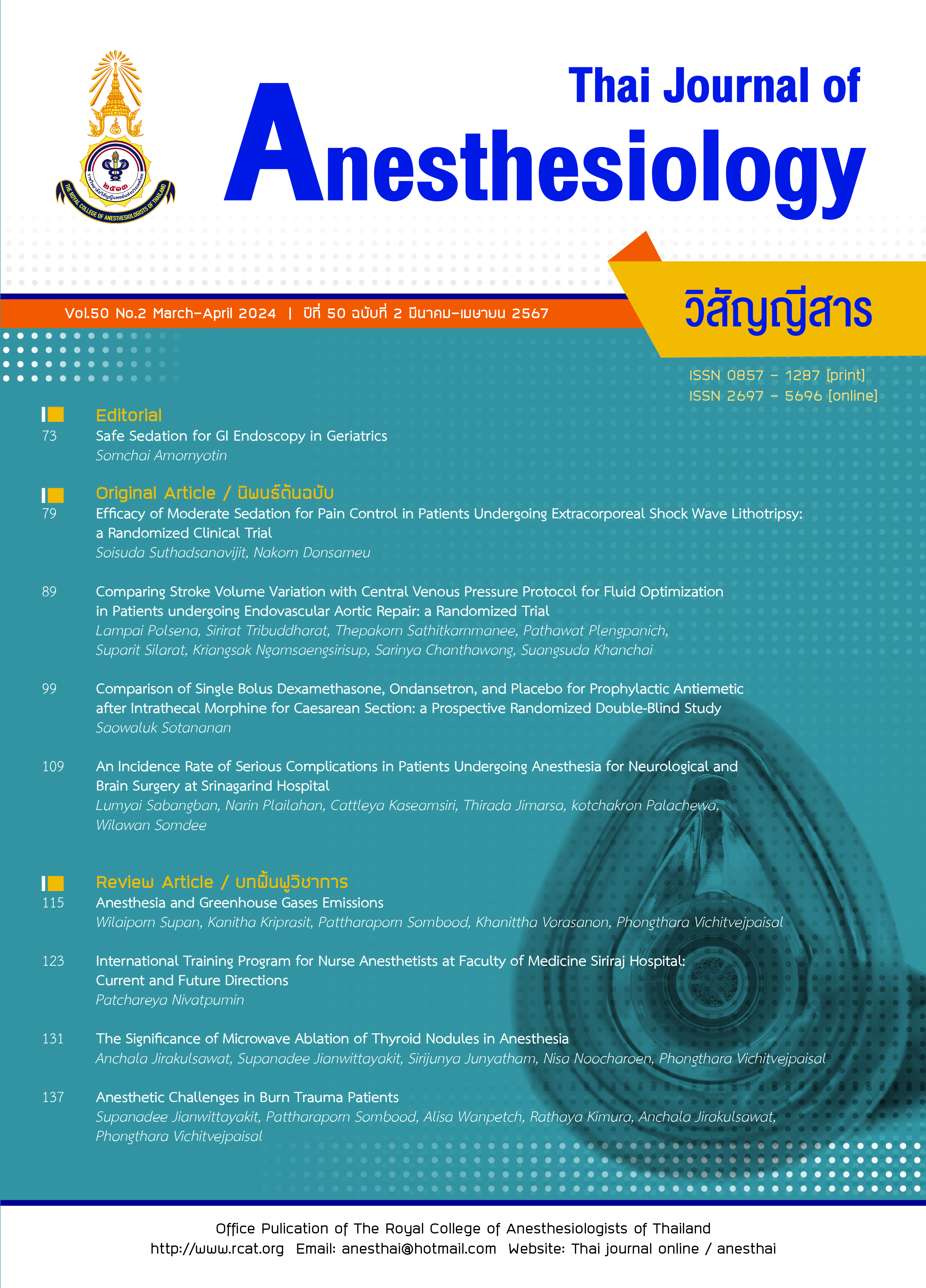Efficacy of Moderate Sedation for Pain Control in Patients Undergoing Extracorporeal Shock Wave Lithotripsy: a Randomized Clinical Trial
Main Article Content
Abstract
Introduction: Extracorporeal shock wave lithotripsy (ESWL) is a painful procedure. Effective analgesia is mandatory to achieve patient comfort and in cooperating according to the treatment plan. The objective of the study is to evaluate pain relief from moderate to severe (pain score, PS ≥4) to mild pain (PS 0-3) with parenteral propofol-fentanyl (moderate sedation) and preemptive etoricoxib combined with acetaminophen (conventional treatment) during ESWL. Methods: Seventy patients scheduled for ESWL were randomized by a computer program and sealed envelope. Thirty-five samples were assigned to propofol-fentanyl (PF) as the experimental group, and thirty-five samples were assigned to etoricoxib-acetaminophen (EA) as the control group. The primary outcome was to evaluate the efficacy of moderate sedation for pain control. Pain was assessed using an 11-point numeric rating scale (NRS) and ≤3 was considered adequate analgesia. Secondary outcomes included complications, recovery time, health care and patient satisfaction using the Modified Aldrete score, Modified Post-anesthesia Discharge Scoring System (PADSS) and visual analog scale (VAS) for satisfaction Results: Sixty-eight patients completed the present study, with no differences in demo- graphics data or baseline vital signs. Group PF reported less PS than group EA (P<0.001). After ranging the severity of pain, moderate to severe pain was 2 (5.9%) and 29 (85.3%), respectively (P<0.001). All patients underwent a planned ESWL without major complications. Most patients achieved a Modified Aldrete score ≥9 within 5 min of the end of ESWL. Although the recovery time of group PF was slower than group EA, it was not clinically significant. The median time for patients to achieve PADSS ≥10 was 10 and 0 min, and the median time for patients to feel full recovery was 40 and 5 min, respectively (P<0.001). Furthermore, group PF had better overall satisfaction than group EA. Conclusion: A combination of propofol and fentanyl for moderate sedation can provide effective anesthesia during ESWL. Furthermore, it facilitates ESWL to be established plan, safely and increases overall satisfaction.
Article Details

This work is licensed under a Creative Commons Attribution-NonCommercial-NoDerivatives 4.0 International License.
References
Chewcharat A, Curhan G. Trends in the prevalence of kidney stones in the United States from 2007 to 2016. Urolithiasis. 2021;49:27-39.
Nettuwakul C, Praditsap O, Sawasdee N, et al. Genetic heterogeneity of kidney stone disease in northeastern Thai patients. Genomics Genetics. 2022;15:1-15.
Yanagawa M, Kawamura J, Onishi T, et al. Incidence of urolithiasis in northeast Thailand. Int J Urol. 1997;4:537-40.
Fink HA, Wilt TJ, Eidman KE, et al. Medical
management to prevent recurrent nephrolithiasis in adults: a systematic review for an American College of Physicians Clinical Guideline. Ann Intern Med. 2013;158:535-43.
Saigal CS, Joyce G, Timilsina AR, Urologic Diseases in America Project. Direct and indirect costs of nephrolithiasis in an employed population: opportunity for disease management? Kidney Int. 2005;68:1808-14.
Salinas AS, Lorenzo-Romero J, Segura M, et al. Factors determining analgesic and sedative drug requirements during extracorporeal shock wave lithotripsy. Urol Int. 1999;63:92-101.
Bach C, Zaman F, Kachrilas S, Kumar P, Buchholz N, Masood J. Drugs for pain management in shock wave lithotripsy. Pain Res Treat. 2011;2011:259426.
Gupta NP, Kumar A. Analgesia for pain control during extracorporeal shock wave lithotripsy: current status. Indian J Urol. 2008;24:155-8.
Liu SS, Strodtbeck WM, Richman JM, Wu CL. A comparison of regional versus general anesthesia for ambulatory anesthesia: a meta-analysis of randomized controlled trials. Anesth Analg. 2005;101:1634-42.
Vandeursen H, Pittomvils G, Matura E, Boving R, Baert L. Anesthetic requirements during electromagnetic extracorporeal shock wave lithotripsy. Urol Int. 1991;47:77-80.
Kaygusuz K, Gokce G, Gursoy S, Ayan S, Mimaroglu C, Gultekin Y. A comparison of sedation with dexmedetomidine or propofol during shockwave lithotripsy: a randomized controlled trial. Anesth Analg. 2008;106:114-9.
Coloma M, Chiu JW, White PF, Tongier KW, Duffy LL, Armbruster SC. Fast-tracking after immersion lithotripsy: general anesthesia versus monitored anesthesia care. Anesth Analg. 2000;91:92-6.
Medina HJ, Galvin EM, Dirckx M, et al. Remifentanil as a single drug for extracorporeal shock wave lithotripsy: a comparison of infusion doses in terms of analgesic potency and side effects. Anesth Analg. 2005;101:365-70.
Rego MMS, Watcha MF, White PF. The changing role of monitored anesthesia care in the ambulatory setting. Anesth Analg. 1997;85:1020-36.
Rego MMS, Inagaki Y, White PF. Remifentanil administration during monitored anesthesia care: are intermittent boluses an effective alternative to a continuous infusion? Anesth Analg. 1999;88:518-22.
Cortínez LI, Muñoz HR, De la Fuente R, Acuña D, Dagnino JA. Target-controlled infusion of remifentanil or fentanyl during extra-corporeal shock-wave lithotripsy. Eur J Anaesthesiol. 2005;22:56-61.
Monk TG, Boure B, White PF, Meretyk S, Clayman R. Comparison of intravenous sedative-analgesic techniques for outpatient immersion lithotripsy. Anesth Analg. 1991;72:616-21.
Gesztesi Z, Rego MMS, White PF. The comparative effectiveness of fentanyl and its newer analogs during extracorporeal shock wave lithotripsy under monitored anesthesia care. Anesth Analg. 2000;90:567-70.
Cheewaitsarakul P, Chaiyaprasithi B, Soontrapa S. Etoricoxib compared with fentanyl during
extracorporeal shock wave lithotripsy (ESWL). Thai J Urol. 2006;27:30-3.
Mitsogiannis IC, Anagnostou T, Tzortzis V, et al. Analgesia during extracorporeal shockwave
lithotripsy: fentanyl citrate versus parecoxib
sodium. J Endourol. 2008;22:623-6.
Akcali GE, Iskender A, Demiraran Y, et al. Randomized comparison of efficacy of paracetamol, lornoxicam, and tramadol representing three different groups of analgesics for pain control in extracorporeal shockwave lithotripsy. J Endourol. 2010;24:615-20.
Pimratana C, Hengsawat K. The analgesic effect of cryotherapy on patients undergoing extracorporeal shock wave lithotripsy: a randomized controlled trial. Siriraj Med J. 2022;74:85-90.
Joo HS, Perks WJ, Kataoka MT, Errett L, Pace K, Honey RJ. A comparison of patient-controlled sedation using either remifentanil or remi-
fentanil-propofol for shock wave lithotripsy. Anesth Analg. 2001;93:1227-32.


